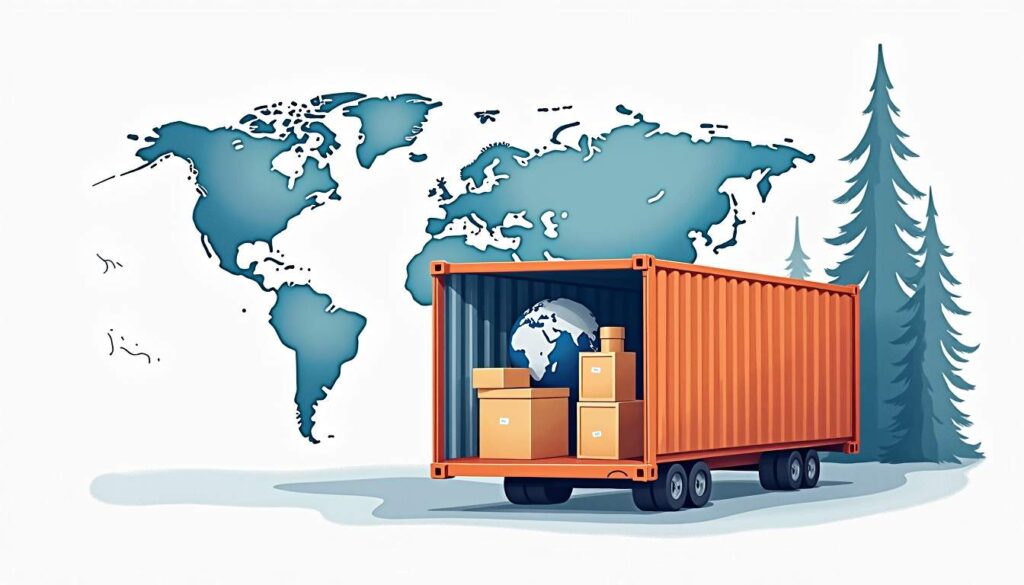Shipping your belongings overseas can seem like a daunting task, but with the right knowledge and preparation, it can be a smooth process. In this article, we will explore the essentials of overseas shipping, including various options, costs, and essential regulations to consider.
Understanding the Basics of Overseas Shipping
Before diving into the specifics, it’s crucial to understand what overseas shipping entails. It involves transporting goods from one country to another, and it can vary greatly based on the mode of transport, the type of goods, and the destination.
What is Overseas Shipping?
Overseas shipping is the process of sending items across international borders. This can be done via various methods, including air freight, sea freight, or even land transport in certain cases. Depending on the service chosen, delivery times can range from a few days to several weeks.
Understanding the intricacies of overseas shipping allows individuals and businesses to make informed decisions, ensuring that their belongings arrive safely and efficiently. It’s also important to appreciate that each destination country has its unique shipping requirements. For instance, some countries may have strict regulations regarding the import of certain goods, necessitating a thorough understanding of customs documentation and tariffs. This knowledge can prevent delays and additional costs that may arise from non-compliance.
Why Choose Overseas Shipping?
One of the primary reasons to opt for overseas shipping is the ability to reach global markets. For businesses, shipping products overseas can expand their reach significantly. For individuals, it allows for the transportation of personal belongings when relocating to a new country.
In many cases, overseas shipping is cost-effective compared to domestic shipping options, especially for larger shipments. Moreover, with advancements in logistics and technology, overseas shipping has become more reliable and faster. The rise of tracking technology has also transformed the shipping experience, enabling both senders and recipients to monitor their shipments in real-time. This transparency not only enhances customer satisfaction but also allows businesses to manage their inventory more effectively. Additionally, many shipping companies now offer insurance options, providing peace of mind that goods are protected against unforeseen circumstances during transit.
Preparing Your Belongings for Shipment
Preparation is key when it comes to overseas shipping. Properly packing and organizing your items can save time, reduce shipping costs, and prevent damage during transit.
Packaging Essentials for Overseas Shipping
When preparing your items for shipment, using quality packing materials is vital. Sturdy boxes, bubble wrap, and packing tape should be your go-to supplies. Ensure that fragile items are well-protected and label boxes clearly to indicate their contents.
In addition to the physical packing, consider weight and size restrictions imposed by shipping companies. Overpacking can lead to increased costs, while underpacking can risk damage to your belongings. Always measure and weigh your packages before heading to the shipping provider. Additionally, it’s wise to research the specific regulations of the destination country, as certain items may be prohibited or require special handling. This proactive approach can save you from unexpected delays or additional fees at customs.
Item Inventory and Insurance
Creating a detailed inventory of your items is essential when shipping overseas. This list should include a description of each item, its value, and whether it is new or used. This inventory can be critical for customs documentation and insurance claims should any item go missing or get damaged.
Speaking of insurance, it’s advisable to purchase coverage for your shipment. Many shipping companies offer varying levels of insurance, providing peace of mind that your belongings are protected during transit. Furthermore, consider documenting your items with photographs before packing them. This visual record can serve as additional proof of condition and value, making it easier to resolve any disputes with shipping companies or insurance providers. In some cases, you may also want to explore third-party insurance options, which can sometimes offer more comprehensive coverage than standard shipping insurance.
Exploring Different Shipping Options
Once your belongings are prepared, the next step is to choose the appropriate shipping option. Several factors will influence this decision, including cost, delivery speed, and the destination. Understanding the nuances of each shipping method can help you make an informed choice that aligns with your needs and budget.
Air Freight vs. Sea Freight
Air freight is the fastest way to ship items internationally, often taking just a few days. However, it tends to be more expensive than sea freight. This option is ideal for urgent shipments or valuable items that need a quick turnaround. Additionally, air freight is often preferred for shipping perishable goods or high-value electronics, as the reduced transit time minimizes the risk of spoilage or damage.
Conversely, sea freight is more economical for larger shipments, typically taking weeks to arrive. It’s suitable for individuals or businesses looking to send bulk items or those who can afford to wait longer for delivery. Moreover, sea freight allows for the transport of oversized cargo that may not fit within the constraints of air freight, making it a versatile choice for various shipping needs. Importantly, many shipping companies offer a range of container sizes, allowing you to choose the best fit for your load, which can further optimize costs.
Door-to-Door vs. Port-to-Port Shipping
The choice between door-to-door and port-to-port shipping can significantly impact your moving experience. Door-to-door shipping means the shipping company will pick up your items from your location and deliver them directly to your new address overseas. This option is particularly advantageous for those who are unfamiliar with the logistics of international shipping, as it alleviates the stress of coordinating multiple transportation steps.
Port-to-port shipping, on the other hand, requires you to manage the transportation to and from port terminals. This option may save costs but requires more effort on your part. It’s essential to weigh the convenience of door-to-door against the potential savings of port-to-port shipping. Additionally, if you choose port-to-port, it’s crucial to consider customs clearance processes, as you will need to ensure that all necessary documentation is in order to avoid delays. Understanding the requirements for both shipping methods can help you navigate the complexities of international logistics more effectively, ensuring a smoother transition to your new location.
Deciphering Shipping Costs
Understanding shipping costs is crucial for budgeting effectively. Various factors can influence the overall price you’ll pay for shipping your belongings overseas.
Factors Influencing Shipping Costs
Several elements contribute to the shipping cost, including:
- Weight and Volume: The heavier and bulkier your shipment, the more expensive it will be.
- Shipping Method: Air freight is generally pricier than sea freight, while express options cost more than standard services.
- Distance: The longer the distance, the higher the cost, particularly for international shipping.
Understanding these factors can help you choose options that fit your budget without compromising your needs.
Hidden Costs in Overseas Shipping
It’s important to be aware of potential hidden costs when shipping overseas. Some common hidden fees include customs duties, storage fees at ports, and additional charges for specialized packing services.
To avoid surprises, always ask your shipping provider for a detailed breakdown of costs. Being informed can help you make better financial decisions and ensure a smoother shipping process.
Navigating Customs and Regulations
Understanding customs and regulations is a vital step in shipping overseas. Each country has its rules regarding what can be imported, which can affect your shipment.
Understanding Customs Duties and Taxes
Customs duties and taxes can significantly impact the total cost of shipping your belongings. Depending on the destination country, these tariffs may apply to your goods upon arrival. It is essential to research the specific regulations for your destination to budget accordingly.
Many countries have exemptions for certain goods or lower rates for personal items, so it’s worth investigating these details when planning your shipment.
Complying with International Shipping Regulations
Each country adheres to its regulations concerning shipping. Compliance with these regulations is crucial to avoid delays or confiscation of goods. This includes knowing what documentation is necessary and ensuring all items comply with the destination country’s safety and quality standards.
Consulting with your shipping provider or a customs broker can help streamline this process and provide guidance on the necessary steps to ensure your shipment arrives without complications.
By understanding the complete process from preparation to customs, you’ll be well-equipped to ship your belongings overseas with confidence.
















